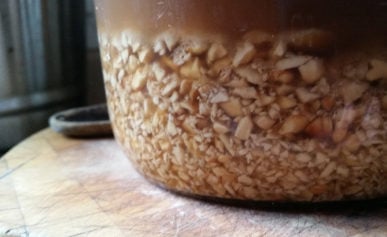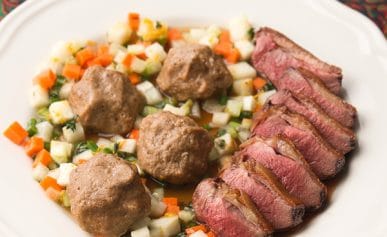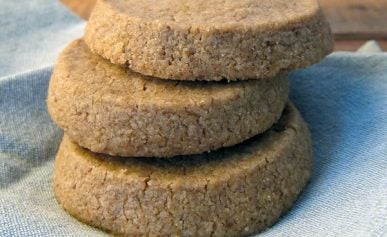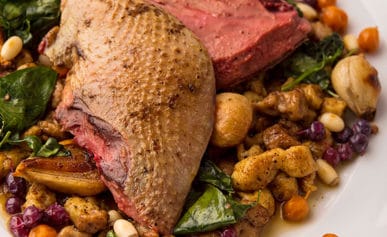As an Amazon Associate I earn from qualifying purchases.
Yes, you can eat acorns, and all acorns are edible — it’s just that most need special processing. Here’s how to go about it.

If you haven’t read my other acorn posts, Acorns and the Forager’s Dilemma is an introduction to the use of acorns; the Forager’s Dilemma is, in a word, starch. Starch (carbohydrates) is the toughest thing to gather, and is a primary reason why humans settled down 10,000 years ago to grow grain.
Next I wrote about how various world cultures have traditionally used acorns, cultures ranging from Korea to Japan to the Native Americans, Europeans and North Africans.
Let me say loud and clear that you can eat acorns and all acorns are edible, at least all species of acorns are. We’ll get into details in a bit.
Basically there are three ways to eat acorns: Eating them as nuts (they are a lot like chestnuts), making acorn flour, or cooking in acorn oil. I have not yet tried to make acorn oil, but that link leads you to my friend Sam Thayer’s website; he sells it.
Collecting Edible Acorns
First you need to get yourself a supply of acorns. Go find some oak trees; they’re the ones with all the acorns that have fallen down around them. I know this sounds condescending and stupid, but oaks come in so many varieties that in autumn this really is the easiest way. It is a bit of a crapshoot, as it is tougher to determine a variety of oak by its acorn than by its the leaf — you can do it, but it is a little harder.
You can gather acorns anytime from September until early spring. I find gathering as the acorns fall is best. Suellen Ocean, who wrote a very useful book Acorns and Eat ’em,says she likes to collect Tanoak acorns in February and March, after many have begun sprouting.
She says acorns with sprouts between 1 to 2 inches long are still good to eat, but discard any acorn meats that have turned green. Ocean says recently sprouted acorns a) have begun to turn their starch into sugar, and b) are foolproof: “If it is sprouted, it’s a good acorn and I haven’t wasted time gathering wormy ones.”
A word on worms. When I first gathered acorns, little did I know that I had gathered scores already infected with the larva of the oak weevil. Nasty little maggoty things, you can tell they are inside your acorn if there is a little hole in the shell. Look for it, discard that acorn and move on. But know that oak weevil larvae bored those holes from the inside out. Like Alien.
It’s helpful to know what kind of oak you are dealing with because acorns from different oaks have different levels of tannins in them; more on that in a bit. If you don’t know your trees, start looking for little green acorns in May. Pick a leaf and compare it to oak leaves online or in a guidebook. Gather acorns and compare them to online images and guidebooks; different oaks bear acorns with different shapes.
With that in mind, remember that not all oaks are created equal, and the fundamental fact to know if you are going to eat acorns is that you are dealing with a wild food, and as such must contend with tremendous variability, both in species and even among individuals of the same species.
Some oaks bear acorns so low in bitter tannins that they can be eaten raw. Legend says that California Indians fought over these trees, which makes some sense because one mature Valley Oak can drop 2,000 pounds of acorns in a really good year. A ton of sweet acorns may well be worth fighting over.
That said, even “sweet” acorns should be leached to remove what tannins exist in them because several studies show that unleached acorns can make you constipated and can harm your teeth. Of all the species I know of, only the imported European cork oak and the Emory oak of the Sonoran Desert come close to being “sweet.”
Tannins aren’t the only thing that makes different species of acorn different. UC Riverside Professor David Bainbridge wrote in a 1986 academic paper that depending on species, acorns can range in fat content from 1.1 percent to 31.3 percent, protein from 2.3 percent to 8.6 percent, and carbohydrates from 32.7 percent to 89.7 percent. That is a huge range!
What does it mean? It means that in the kitchen you treat acorns from different species very, very differently. A fatty acorn will make a meal, like ground almonds. A carb-rich acorn — like Valley Oak acorns — makes a drier flour, more like chestnut or chickpea flour (acorns lack gluten and so will not rise.)

Differences in Various Oaks
Here’s a general breakdown:
‘Sweetest’ Acorns, meaning lowest in tannin: East Coast white oak, the Emory oak of the Southwest, the pin oak of the South, the valley and blue oaks of California, the burr oak of the Midwest, as well as the cork oak and the well-named bellota oak of Europe. To my California readers, know that there are an awful lot of cork oaks and burr oaks planted in towns and cities here, so keep your eyes peeled.
Largest Acorns: Valley oaks are really big, as are East Coast White oaks. Burr oaks are large, too, as is the California Black oak.
Fattiest Acorns: The Eastern red oak acorns I’ve used have a very high oil content, and I’ve read that the Algonquin used red oak acorns for oil. In the West, the champions are both live oaks, the Coastal and the interior live oak, as well as the tanoak and black oak, which is Quercus kellogii.
Shelling Acorns
I found that shelling the acorns is the most onerous part of dealing with them. They have an elastic shell that resists normal nut crackers. I found whacking them with a hammer to be the best way to open up an acorn. Some people use a knife, and I do this with green acorns, but not fully ripe ones.
Best way to whack ’em is to put the flat end (the side that used to have the cap) on a firm surface and rap the pointy end with a hammer, or, with long, tapered acorns like cork oak or Valley oaks, just whack the side.
Acorns are far easier to shell after they’ve dried. If you choose to dry them, do this in wide, shallow pans so they don’t get moldy. Once dried, I’ve worked with two-year-old acorns and they were fine. They will need an overnight soak before grinding, however.
Red oak acorns have a “test,” a skin that doesn’t want to come off, just like a chestnut. Easiest way to deal with this is to freeze your fresh acorns for a week or two before cracking. This will slip the skin off the nut. The skin is bitter, but it’s not that big a deal if you are making flour.
Shell your acorns into water. The meats oxidize, and you will get a lighter-colored flour if you do this. It’s aesthetic, but it matters to me.
Tannins
All acorns should be leached with water to remove bitter tannins, which will a) make your mouth feel and taste like felt, b) make you a bit nauseous, and possibly c) constipate you for days.
Getting those tannins out is the big barrier to cooking with acorns. But it ain’t no biggie. With my valley oak acorns, after shelling I drop the acorn meats directly into my stockpot that was two-thirds full of water. When I fill the pot about a third of the way up with shelled acorns, if I am in a hurry, I bring the pot of water to a boil. The water turns dark. As soon as it boils, pour the water off into the sink and repeat the process.
It requires about five changes of water to get valley oak acorns to taste like chestnuts. I did this all while watching football, and did not miss a snap. Other oaks will require more or fewer changes of water. Choose the “sweetest” acorns on my list above for the least amount of work.
There is a better method, but it takes days. Grind the raw acorns into flour, then mix a ratio of 1 cup of acorn meal to 3 cups water, or more water if you have large containers. Pour this all into a glass jar with a lid and put it in the fridge. Every day you shake the jar, wait 12 hours or more, then pour off the water — and the tannins.
How long? Anywhere from a week to two weeks, depending on how bitter your acorns are. This is a good way to leach acorns without using fuel for boiling water, and you do not denature a particular starch in the acorns that acts a little like the gluten in flour, i.e., it helps the flour stick to itself. I go into the full process of cold leaching acorns here.
If you plan on baking with the acorn flour, use the cold-water leaching method.

Once your acorns are free of tannins, you need to figure out what to do with them. Regardless, you need to dry them first or they will rot. Acorn grits can be patted dry on a tea towel. If it is hot out, lay the acorns out on cookie sheets and dry in the shade. You could also put them in an oven set on “warm.” You can also put the acorns in a dehydrator set on low heat, which is what I do.
You can also freeze your fresh acorn meal. Store dried flour in jars in the fridge. Why the fridge? What fat there is in acorns will go rancid pretty quick if you left the flour at room temperature.
What you can now do to eat acorns is pretty limitless.
My first success was an acorn flour flatbread in the style of an Italian piadina. I also make an acorn flour honey cake, which is really very tasty — almost like gingerbread cake. The flour also makes an excellent pasta dough when mixed with regular flour.
Other Ways To Eat Acorns

Acorn Grits
Acorn grits, which are useful additions to acorn soup, acorn muffins or to eat as a breakfast cereal.
Read More
Wood Duck and Acorn Dumplings
Acorn dumplings, served with wood duck — wood ducks eat acorns, so it seemed fitting.
Read More
Acorn Maple Shortbread Cookies
Acorn cookies, more or less like shortbread. A bit tricky to make, but even if they fall, they are still delicious.
Read More
Acorn Spätzle
Acorn spätzle, little German dumplings that work very well with gluten free acorn flour.
Read MoreI will also substitute about 1/5 of the flour in my homemade flour tortillas with acorn flour, and I also make mean acorn gnocchi.
Use your imagination!









Aside from honey, what do you recommend as a natural source of sugar for preserves, baking etc. Also, sourse of salt? We rely on both for preservation without refrigeration. BTW, I hope your retreat helped you figure out the next steps in your life.
We have a tree that is putting off acorns. How long do I have to wait before they are ready to eat? There is an abundance of them and I hate to see them go to waste. I know nothing about them. I picked them off the ground because I was told that’s when they are ready. I busted 2 open they are a Beautiful pale yellow but they are kinda of bitter. I removed the skin but they don’t have much flavor. I have never ate them except with other nuts. So any advice or whatever you can offer me would be greatly appreciated. Thank You and Have A Blessed Day.
Kimberley: When they fall, they are ready. Almost all acorns must be leached of their bitter tannins with many changes of water.
Can you roast acorns, like pine nuts or chestnuts ect.
Tanner: Kinda? It works with very low tannin acorns like the Emory oak in Arizona, and with certain white oak acorns – but you’ll only know which white oaks have the “sweetest” acorns by trying them, which is a tiresome process.
I’ve got a tip that will speed up the process of separating the good acorns from the weevil infected acorns. Take the unsorted haul of acorns and dump them into a barrel or large pail of water. The infected acorns will float to the surface and are easily skimmed off and discarded. The uninflected nuts sink to the bottom. Those are the keepers that can be dried or otherwise processed.
Any advice on which color acorns to gather? Of those that are intact (no squirrel bites etc) I’m seeing bright green, to green with spots of brown, to brown.
Thanks!
Maggie: I only gather brown ones.
Hello cousin (I’m a Shaw)
I found this while looking for green acorn jam recipe- I thought they might be jammable like walnuts are.
Thanks for the detail and I’m going to give this a go. Two questions on acorns and tannins etc:
1. Could you or would you just pop acorns into some gin with sugar and leave to steep, like with sloe gin, and then would the tannins be somehow neutralised or made unharmful by the alcohol?
2. Must you dry the flour if you’re leaching ground acorns in the fridge, or can you cook with it just strained and wet?
Ruth
Ruth: No, because tannins are water soluble and they would leach into the gin. You can definitely cook with it strained and wet, but the measurements might well be off if you are using a recipe.
Any comment on the acorns from a Turkey Oak (Quercus laevis)?
Harley: I’ve not worked with them.
Can I eat them as a snack after boiling them 3 times shelled and chopped. I got most of the color out of the water by the 3rd boil. Can I eat them if it’s a small hand full or do i have to dry them too?
Thank you Happy New Year
Angela: Sure, you can eat them, and you will immediately know if they are too bitter.
Hank, thanks for your very informative page, much deeper knowledge than the usual stuff you find on the www.
From what you say, white oaks, Quercus alba, do not all produce the same level of tannins in the nut, though the species may produce the sweetest nut, on average. I hadn’t realized that there’d be such variations in all the major nutrients. In any event, there’s a friendly white oak tree near me that offers very sweet acorns, though it doesn’t produce every year.
I also have to wonder how many nutrients we lose with extensive leaching. We probably don’t lose too much of the fat soluble ones, but certainly much of the water soluble ones go the way of the tannins: down the drain.
I just picked up about two pounds of acorns dropped from a Live Oak. The acorns do not have a inner skin and are very mild with only a light tannin flavor when raw so I would guess they are from the white oak family. Would it be possible to roast them with the shells on then remove the meat before soaking the tannins out. I would think it would be easier to shell the acorns after roasting them and since the acorns are small sized and any way to make shelling them easier would be worth it.
Edward: I would not do that because the roasting process “sets” the starches in the meats, so you won’t have flour that will stick to itself later. You can dry the acorns at cooler temperatures, though, and preserve those starches.
We have coastal oaks. How would I treat acorns from these trees? Thank you!
Amanda: You treat all species the same way. The difference is in tannin and fat levels. In reality the first comes into play in leaching time. More tannic acorns need more time. The second is in storage. Fattier meal should be kept in the fridge or freezer. And since I don’t know the fat content in many cases, I always store the meal or flour in the freezer.
Thanks for the comprehensive how to. The only things I don’t understand are 1) why you want a light-colored flour. Is it completely aesthetic? and 2) why are you concerned about not gelantinizing the starches in the acorns? I’m tempted to dry my flour in a slow oven which will be about 180 degrees.
Thanks
Lisa: It is aesthetic, yes, because unless you are a fan of pumpernickel, the products made with the dark flour can be visually alarming. I am concerned about the starches because that is how acorn flour sticks to itself. It is basically the same effect you get with nixtamal, the masa dough for corn tortillas. Without those starches, the acorn flour won’t have any ability to adhere to itself, making it tougher to use.
I love acorn flour, fyi, it makes a wonderful cheesecake crust. I also honey roasted some acorns, ground them up, and used them in hot drinks and to mix in with cookies etc. So yummy.
Hi there! I have a white bur oak tree that has been producing acorns for several years. I use many of the acorns in crafts, but I have been saving several in the shells to eventually turn into flour. Are the acorns safe to eat after several years in shell? I understand the bur oak may not be the best acorn for storage. Just wondering if you have any thoughts or information you could pass along for me before I try to leach out and eat the acorns after several years in storage? Thank you so much!
Steph: Several years? That might be pushing it. But I have made acorns into flour 1 year later.
Have vitamin content been explored with acorns?
Kat: I think so, but you’d have to research it. Use Google Scholar to search.
Thank you so much for this article and the recipes. I have what seems like tons of acorns falling this year. They did so last year too. I am told the oaks I have are White Oaks. Anyway, this year trying to remove all the oak sprouts from the lawn and garden areas from last year’s fall has been a constant process. This year it is very uncomfortable to walk or even keep my balance due to the layer of acorns. So I decided to harvest them to process. I know it’s going to be a major task for me, but your article makes it feel doable and worthwhile. Oh great! one more harvesting thing added just when I thought I was about done . . . Kind of excited to see how it turns out.
My swamp chestnut oak acorns turned dark (oxidated) when drying- dark brown- after soaking the tannins out are they safe still?
Where can I buy good edible oak acorns or shelled acorns, acorn meal and flour? Any online store you would suggest, please?
Thank you!
Could you make a nut butter out of the fattier acorns or would the leaching process prohibit that?
JOnathan: I’ve never been successful trying to make it into a nut butter all by itself, but it might be possible with a very fatty variety, or with a little added fat.
I have a question. Can you leach tannins out of a whole, unground acorn?
Cynthia: Not really. I’ve tried it. I have succeeded with big pieces of cork oak, which is very light in tannins, and you might be able to find a Valley oak that is particularly light in tannins to try it with. But in general, the best you can do is make acorn grits and leach them.
I had been under the impression that you ate certain varieties of acorns whole, like chestnuts. (After putting them through about 5 cycles of hot or boiling water.) Maybe I misunderstood.
Betsy: There are a very few varieties of acorns where this will work, but the vast majority are too tannic for that process. If you want to try it, look for white oaks, cork oaks, or emory oaks.